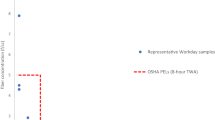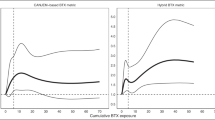Abstract
Quality of exposure assessment has been shown to be related to the ability to detect risk of lymphohematopoietic disorders in epidemiological investigations of benzene, especially at low levels of exposure. We set out to build a statistical model for reconstructing exposure levels for 2898 subjects from 501 factories that were part of a nested case-cohort study within the NCI-CAPM cohort of more than 110,000 workers. We used a hierarchical model to allow for clustering of measurements by factory, workshop, job, and date. To calibrate the model we used historical routine monitoring data. Measurements below the limit of detection were accommodated by constructing a censored data likelihood. Potential non-linear and industry-specific time-trends and predictor effects were incorporated using regression splines and random effects. A partial validation of predicted exposures in 2004/2005 was performed through comparison with full-shift measurements from an exposure survey in facilities that were still open. Median cumulative exposure to benzene at age 50 for subjects that ever held an exposed job (n=1175) was 509 mg/m3 years. Direct comparison of model estimates with measured full-shift personal exposure in the 2004/2005 survey showed moderate correlation and a potential downward bias at low (<1 mg/m3) exposure estimates. The modeling framework enabled us to deal with the data complexities generally found in studies using historical exposure data in a comprehensive way and we therefore expect to be able to investigate effects at relatively low exposure levels.
This is a preview of subscription content, access via your institution
Access options
Subscribe to this journal
Receive 6 print issues and online access
$259.00 per year
only $43.17 per issue
Buy this article
- Purchase on Springer Link
- Instant access to full article PDF
Prices may be subject to local taxes which are calculated during checkout






Similar content being viewed by others
Abbreviations
- NCI-CAPM:
-
Chinese Academy of Preventive Medicine
- GM:
-
Geometric Mean
- NCI:
-
National Cancer Institute
- 1ppm benzene:
-
3.19 mg/m3 (25 °C, 1 atm).
References
Divine BJ . Update of a study of crude oil production workers 1946-94. Occup Environ Med 2000; 57: 411–417.
Huebner WW, Wojcik NC, Jorgensen G, Marcella SP, Nicolich MJ . Mortality patterns and trends among 49,705 U.S.-based women in a petroleum company: update 1979-2000. J Occup Environ Med 2010; 52: 99–108.
Kirkeleit J, Riise T, Bråtveit M, Moen BE . Increased risk of acute myelogenous leukemia and multiple myeloma in a historical cohort of upstream petroleum workers exposed to crude oil. Cancer Causes Control 2008; 19: 13–23.
Friesen MC, Coble JB, Lu W, Shu X-O, Ji B-T, Xue S et al. Combining a job-exposure matrix with exposure measurements to assess occupational exposure to benzene in a population cohort in shanghai, china. Ann Occup Hyg 2012; 56: 80–91.
Peters S, Vermeulen R, Portengen L, Olsson A, Kendzia B, Vincent R et al. Modelling of occupational respirable crystalline silica exposure for quantitative exposure assessment in community-based case-control studies. J Environ Monit 2011; 13: 3262–3268.
Vermeulen R, Coble JB, Lubin JH, Portengen L, Blair A, Attfield MD et al. The Diesel Exhaust in Miners Study: IV. Estimating historical exposures to diesel exhaust in underground non-metal mining facilities. Ann Occup Hyg 2010; 54: 774–788.
Lewis RJ, Schnatter AR, Drummond I, Murray N, Thompson FS, Katz AM et al. Mortality and cancer morbidity in a cohort of Canadian petroleum workers. Occup Environ Med 2003; 60: 918–928.
Wong O, Harris F, Smith TJ . Health effects of gasoline exposure. II. Mortality patterns of distribution workers in the United States. Environ Health Perspect 1993; 101 (Suppl 6): 63–76.
Yin SN, Hayes RB, Linet MS, Li GL, Dosemeci M, Travis LB et al. An expanded cohort study of cancer among benzene-exposed workers in China. Benzene Study Group. Environ Health Perspect 1996; 104 (Suppl 6): 1339–1341.
Vlaanderen J, Lan Q, Kromhout H, Rothman N, Vermeulen R . Occupational benzene exposure and the risk of chronic myeloid leukemia: a meta-analysis of cohort studies incorporating study quality dimensions. Am J Ind Med 2012; 55: 779–785.
Vlaanderen J, Lan Q, Kromhout H, Rothman N, Vermeulen R . Occupational benzene exposure and the risk of lymphoma subtypes: a meta-analysis of cohort studies incorporating three study quality dimensions. Environ Health Perspect 2011; 119: 159–167.
Hayes RB, Yin SN, Dosemeci M, Li GL, Wacholder S, Travis LB et al. Benzene and the dose-related incidence of hematologic neoplasms in China. Chinese Academy of Preventive Medicine–National Cancer Institute Benzene Study Group. J Natl Cancer Inst 1997; 89: 1065–1071.
Dosemeci M, Li GL, Hayes RB, Yin SN, Linet M, Chow WH et al. Cohort study among workers exposed to benzene in China: II. Exposure assessment. Am J Ind Med 1994; 26: 401–411.
Dosemeci M, Yin SN, Linet M, Wacholder S, Rothman N, Li GL et al. Indirect validation of benzene exposure assessment by association with benzene poisoning. Environ Health Perspect 1996; 104 (Suppl 6): 1343–1347.
Andridge RR, Little RJA . A review of hot deck imputation for survey non-response. Int Stat Rev 2010; 78: 40–64.
Ibrahim JG, Chen M-H, Lipsitz SR, Herring AH . Missing-data methods for generalized linear models: a comparative review. J Am Stat Assoc 2005; 100: 332–346.
Browne WJ, Draper D . A comparison of Bayesian and likelihood-based methods for fitting multilevel models. Bayesian Anal 2006; 1: 473–514.
Gelman A . Prior distributions for variance parameters in hierarchical models (comment on article by Browne and Draper). Bayesian Anal 2006; 1: 515–534.
Spiegelhalter DJ, Best NG, Carlin BP, van der Linde A . Bayesian measures of model complexity and fit. J R Stat Soc Ser B (Statistical Methodol 2002; 64: 583–639.
Vermeulen R, Li G, Lan Q, Dosemeci M, Rappaport SM, Bohong X et al. Detailed exposure assessment for a molecular epidemiology study of benzene in two shoe factories in China. Ann Occup Hyg 2004; 48: 105–116.
Kromhout H, Vermeulen R . Long-term trends in occupational exposure: are they real? What causes them? What shall we do with them? Ann Occup Hyg 2000; 44: 325–327.
Symanski E, Kupper LL, Hertz-Picciotto I, Rappaport SM . Comprehensive evaluation of long-term trends in occupational exposure: Part 2. Predictive models for declining exposures. Occup Environ Med 1998; 55: 310–316.
Creely KS, Cowie H, Van Tongeren M, Kromhout H, Tickner J, Cherrie JW . Trends in inhalation exposure—a review of the data in the published scientific literature. Ann Occup Hyg 2007; 51: 665–678.
Richardson DB . Temporal variation in the association between benzene and leukemia mortality. Environ Health Perspect 2008; 116: 370–374.
Glass DC, Gray CN, Jolley DJ, Gibbons C, Sim MR, Fritschi L et al. Leukemia risk associated with low-level benzene exposure. Epidemiology 2003; 14: 569–577.
Vlaanderen J, Portengen L, Rappaport SM, Glass DC, Kromhout H, Vermeulen R . The impact of saturable metabolism on exposure-response relations in 2 studies of benzene-induced leukemia. Am J Epidemiol 2011; 174: 621–629.
Dosemeci M, Rothman N, Yin SN, Li GL, Linet M, Wacholder S et al. Validation of benzene exposure assessment. Ann NY Acad Sci 1997; 837: 114–121.
Kromhout H, Symanski E, Rappaport SM . A comprehensive evaluation of within- and between-worker components of occupational exposure to chemical agents. Ann Occup Hyg 1993; 37: 253–270.
Acknowledgements
We are indebted to other members of the Chinese Center for Disease Control and Prevention—U.S. National Cancer Institute Benzene Study Group for high-quality data collection over many years. We are grateful for advice and guidance since 2002 from the members of the Organic Solvents (Benzene) and Cancer Working Group including Drs. Ellen Eisen (Chair), David Christiani, Lawrence Fine, Katherine Hammond, Richard Hornung, Noah Seixias, Jack Siemiatycki, and Jennifer West.
Author information
Authors and Affiliations
Consortia
Corresponding author
Ethics declarations
Competing interests
The authors declare no conflict of interests.
Additional information
Supplementary Information accompanies the paper on the Journal of Exposure Science and Environmental Epidemiology website
Supplementary information
Rights and permissions
About this article
Cite this article
Portengen, L., Linet, M., Li, GL. et al. Retrospective benzene exposure assessment for a multi-center case-cohort study of benzene-exposed workers in China. J Expo Sci Environ Epidemiol 26, 334–340 (2016). https://doi.org/10.1038/jes.2015.44
Received:
Accepted:
Published:
Issue Date:
DOI: https://doi.org/10.1038/jes.2015.44
Keywords
This article is cited by
-
Research development and trends of benzene-induced leukemia from 1990 to 2019-A bibliometric analysis
Environmental Science and Pollution Research (2022)



